|
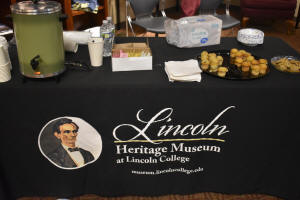

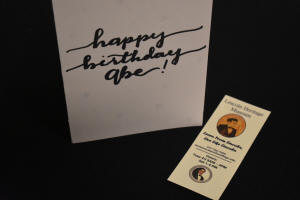
Museum director Ron Keller dressed the part of Honest
Abe and welcomed guests to the museum where they could sign a
birthday card for Lincoln and enter a drawing to win a book about
his life.
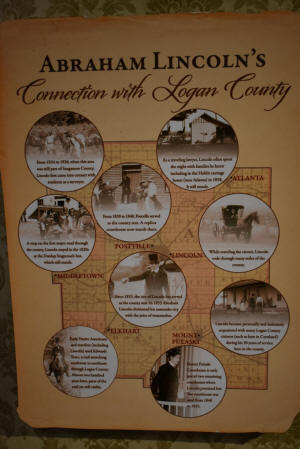


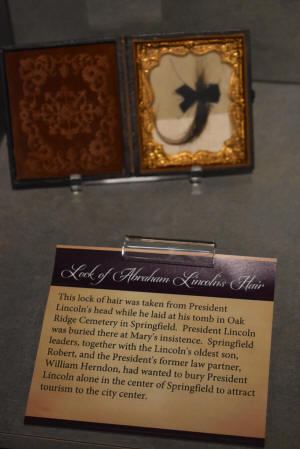
Located on the former Lincoln College campus, the
Lincoln Heritage Museum features a collection of over 100 original
Lincoln-affiliated artifacts including a lock of Lincoln’s hair and
a book of Shakespeare that he carried with him on his travels as a
circuit rider. The collection also includes a lock of his son Tad’s
hair, who died at age 12 while the family was living in the White
House, and a chair that belonged to Tad on which he had carved his
name.

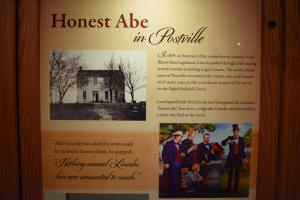

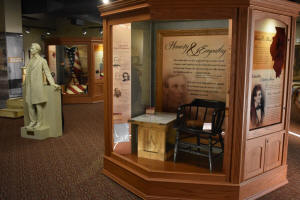
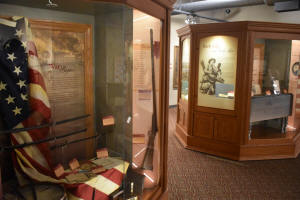
On display are also other books and furniture owned
and used by Lincoln and jewelry, china, a mourning fan, and handbag
belonging to Mary Todd Lincoln. There are also Civil War artifacts
on display including a fife and drum used during battle, a rifle, a
sword with its original scabbard, and a canteen belonging to a
Confederate soldier who traded with a Union soldier at Vicksburg for
the Union canteen full of coffee.
The museum offers information about Lincoln’s childhood and his
Illinois years, as well as his presidential and Civil War years. The
primary focus, however, says Keller, is on “his pre-presidential
years and the man who would become president.” Lincoln’s life before
he was elected president connects him to Illinois, and the museum
proudly displays banners and flags made locally to support his
political campaign. Keller says that Lincoln was “a grassroots
candidate and we have some of those mementos.”
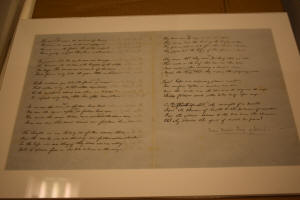

Keller can also convey to visitors the moving story
of Lincoln’s attachment to his favorite poem, “Oh, Why Should the
Spirit of Mortal Be Proud” by Scottish poet William Knox. (The poem
may be read here:
https://www.
loc.gov/resource/rbpe.1580380a/?st=text.)
[to top of second column]
 |

Lincoln read it as a young man while living in New
Salem and committed the 14-stanza poem to memory. Throughout his
life, especially during times when he was experiencing “melancholy”
(what would probably be termed depression today), Lincoln would
write out the poem to comfort himself. There are only two known
copies of the poem that Lincoln wrote in his own hand, and Lincoln
Heritage Museum is proud to have one of them in its possession.


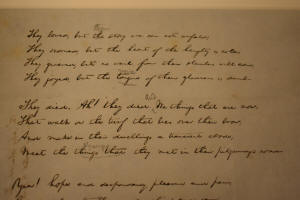
From clues on the document, Keller speculates that
this copy may have been written while Lincoln was in the White
House, perhaps even after the death of his beloved son, Tad.
Although this document is not on public display, LDN received
permission to present photographs of this rare document. Not only is
the document written out by Lincoln, pencil corrections he made,
presumably after writing it from memory, are clearly visible.
The second floor of the museum features an immersive audio-visual
experience of Lincoln’s life. It concludes with reflection on
principles that Lincoln valued and lived in his own life: honesty,
empathy, humility, civility, perseverance, courage, intellect,
vision, responsibility, and leadership. The exhibit and the museum’s
website further explore Lincoln’s commitment to developing
character:
https://museum.lincolncollege.edu/
discover/alccd/profile/abraham-lincoln-character-qualities.
Visitors to the museum may also want to peruse the gift shop which
features a variety of books, including children’s books, as well as
shirts, postcards, statuary, and other souvenirs..
Lincoln Heritage Museum had its beginnings in 1944 with the initial
donation from Judge Lawrence Stringer, an alumnus of Lincoln
University, as it was called at the time. His donation was displayed
in the Lincoln Room of Chapel Hall which served as the
Administration Building. This building burned in 1969 and the
Johnson Center for the Performing Arts was built on the site, so the
collection moved to the McKinstry library building. The current
museum space was purpose built in 2014.

The museum collection grew over the years due to the
efforts of the Lincoln College Board of Trustees and their
connections with Ralph Newman and Jim Hickey. The museum was also
one of the only places collecting and curating Lincoln artifacts
during the mid to late 20th century. There was no other Lincoln
museum with the exception of Fort Wayne, Indiana, so families and
collectors wishing to donate gravitated to Lincoln College as one of
the only places collecting at the time, including Robert Todd
Lincoln Beckwith, Lincoln’s last surviving descendent. The museum
currently holds approximately 20,000 items which counts individual
documents, photographs, and books, as well as other artifacts.
Keller states that the Abraham Lincoln Presidential Library and
Museum (ALPLM) in Springfield is not in competition with the Lincoln
Heritage Museum. “We have the same general themes, but a different
way to tell the story. Some of the things we have are really
unique.”

In fact, the ALPLM sends volunteers to the Lincoln
Heritage Museum, as well as other Lincoln sites in Illinois, so that
they may better direct visitors to the wealth of Lincoln connections
in Illinois. Keller said of the Lincoln Heritage Museum, “We focus
on his character. Not a lot of museums do that. We can look to his
example and we can change our own lives. We do that here. It’s a
noble purpose. Lincoln was not perfect, but we can learn a lot from
him.”

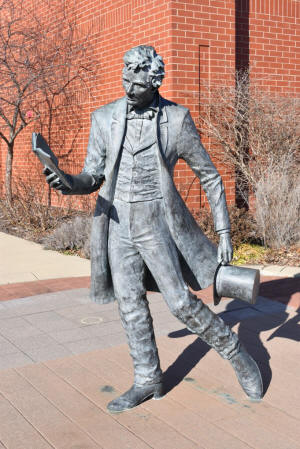
Some area residents may not realize that although
Lincoln College is closed, the Lincoln Heritage Museum continues
regular operations. Tour groups and families from out of state and
even from out of the country make a point to visit this unique
museum which is part of the Abraham Lincoln National Heritage Area (
https://www.lookingforlincoln.org/ ). The museum is open Tuesday
through Friday from 9 a.m.- 4 p.m. and Saturdays from 1-4 p.m. For
more information please call (217) 735-7399 or visit
https://museum.lincolncollege.edu/.
LDN highly recommends setting aside an hour or two
and making a point to visit this local treasure.
[Stephanie Hall] |